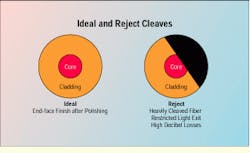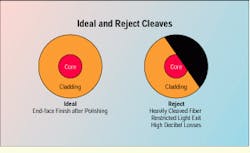Making the perfect cleave
Mike Reed
Methode Electronics Inc.
Problem
When terminating optical fiber, many field technicians experience difficulty achieving consistently good end-face standards because of poor cleaving practices.
Solution
By following a simple procedure using an inexpensive pen-like cleaver, a high-quality and consistent cleave can be produced.
This uniform and repeatable procedure will reduce optical loss and eliminate lost time that results from having to replace damaged connectors. Scrap loss can also be reduced.
Procedure
1) Place the wedge-like blade of the cleaver at the tip of the ferrule and rest it on top of the epoxy bead there.
2) Gently score the fiber several millimeters across the cladding region in one direction. A light touch here will save you from having to reterminate.
3) Grip the excess cleaved fiber and pull it upward and away from the ferrule.
4) Dispose of the excess fiber by putting it in an appropriate waste bin or attaching it to a piece of reversed sticky tape.
5) Gently dress the remaining nub of fiber with a piece of 12-micron alumina-oxide paper.
6) Proceed to final polishing.
A successful cleave (left) produces a low-profile surface, seen here after polishing. An improper cleave (right) results in substandard end-face finish and contributes to high signal loss.
Mike Reed is responsible for all fiber-optic training and field applications at Methode Electronics Inc., Chicago, IL.

